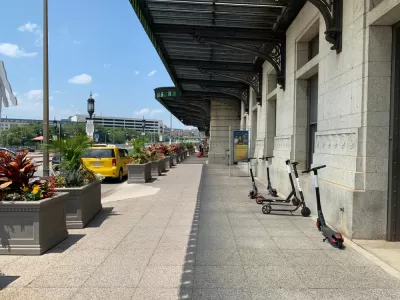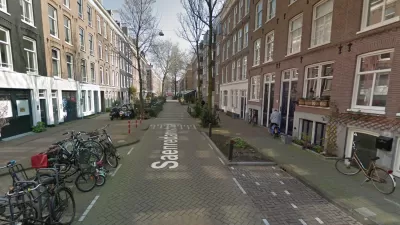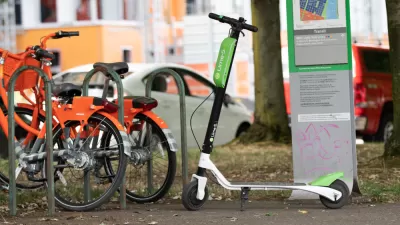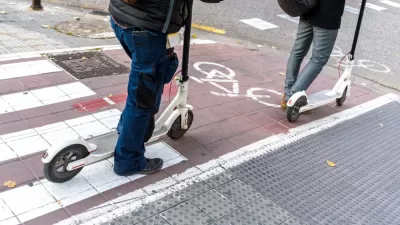The worst offenders of parking violations on the streets today aren't scooters—they're food delivery and ride-hailing drivers.

Daniel Aloi writes to share news of a new study completed by planning researchers from the University of Oregon and Cornell University, with help from Lime and the city of Denver.
“Scooter clutter” has been a concern amplified by media reports in urban areas where micromobility has entered the landscape, with large numbers of dockless scooters and shared e-bikes on city streets and sidewalks. But a recent study finds that motor vehicles are still the main offender by far when it comes to blocking access by other travelers.
The Transportation Research Interdisciplinary Perspectives journal published the study this week. The study examines five cities—Austin, Texas; Portland, Oregon; San Francisco and Santa Monica, California; and Washington, D.C.—for insights into scooter, bike, and car parking behavior. Aloi explains the methodology of the study:
Researchers collected 3,666 observations of e-scooters, bikes, motor vehicles and “sidewalk objects” such as sandwich boards. Research assistants recorded parking behavior on both sides of a busy commercial corridor for three days, eight hours each day. They observed parked cars, scooters and bicycles, as well as sidewalk furniture including advertising, construction materials and sidewalk-mounted elevator or stair-access doors.
And the findings:
The study found that parking noncompliance rates across the five cities were far higher for motor vehicles (24.7% of 2,631 motor vehicles observed) than for micromobility vehicles (0.8% of 865 scooter and bike observations).
As noted by Aloi, most of the car parking noncompliance was generated by food delivery services and ride-hailing companies.
FULL STORY: Study explores micromobility, improper parking in 5 cities

Study: Maui’s Plan to Convert Vacation Rentals to Long-Term Housing Could Cause Nearly $1 Billion Economic Loss
The plan would reduce visitor accommodation by 25,% resulting in 1,900 jobs lost.

North Texas Transit Leaders Tout Benefits of TOD for Growing Region
At a summit focused on transit-oriented development, policymakers discussed how North Texas’ expanded light rail system can serve as a tool for economic growth.

Why Should We Subsidize Public Transportation?
Many public transit agencies face financial stress due to rising costs, declining fare revenue, and declining subsidies. Transit advocates must provide a strong business case for increasing public transit funding.

How Community Science Connects People, Parks, and Biodiversity
Community science engages people of all backgrounds in documenting local biodiversity, strengthening connections to nature, and contributing to global efforts like the City Nature Challenge to build a more inclusive and resilient future.

Alabama: Trump Terminates Settlements for Black Communities Harmed By Raw Sewage
Trump deemed the landmark civil rights agreement “illegal DEI and environmental justice policy.”

Dear Tesla Driver: “It’s not You, It’s Him.”
Amidst a booming bumper sticker industry, one writer offers solace to those asking, “Does this car make me look fascist?”
Urban Design for Planners 1: Software Tools
This six-course series explores essential urban design concepts using open source software and equips planners with the tools they need to participate fully in the urban design process.
Planning for Universal Design
Learn the tools for implementing Universal Design in planning regulations.
City of Santa Clarita
Ascent Environmental
Institute for Housing and Urban Development Studies (IHS)
City of Grandview
Harvard GSD Executive Education
Toledo-Lucas County Plan Commissions
Salt Lake City
NYU Wagner Graduate School of Public Service





























